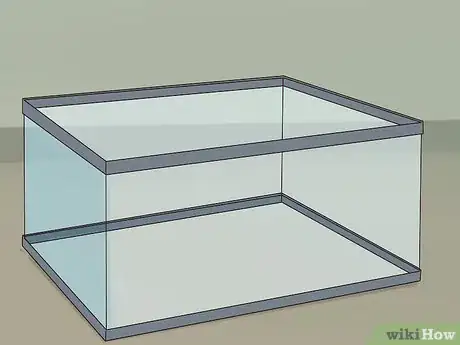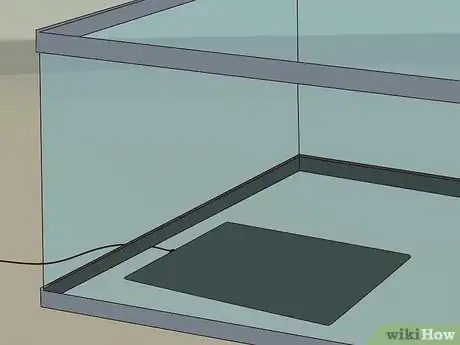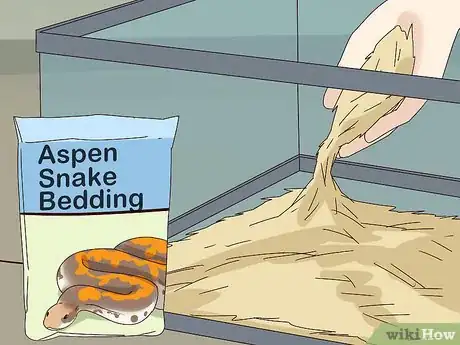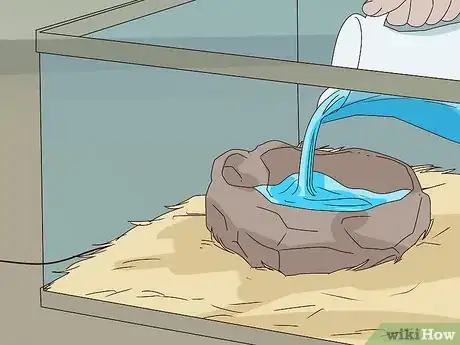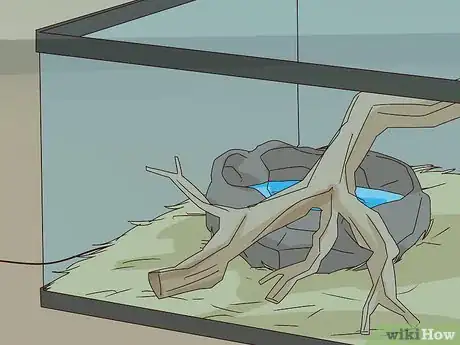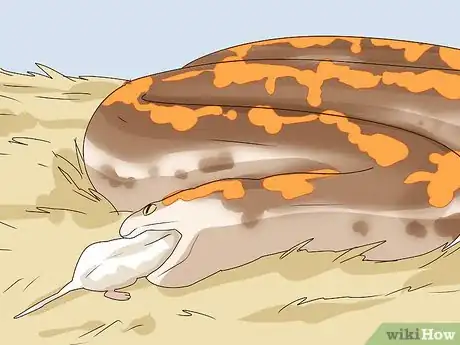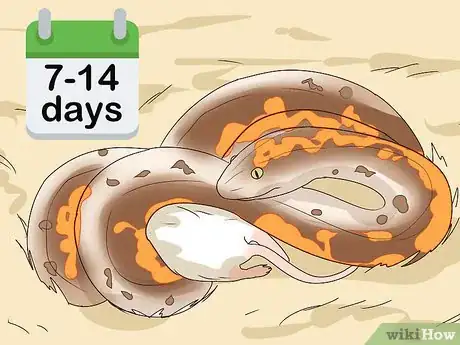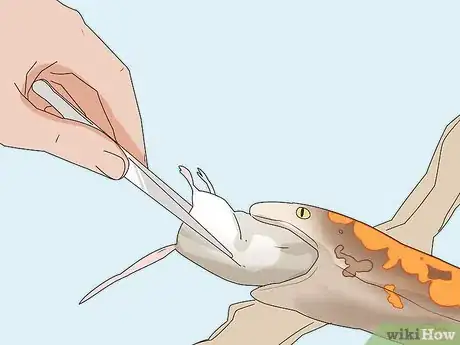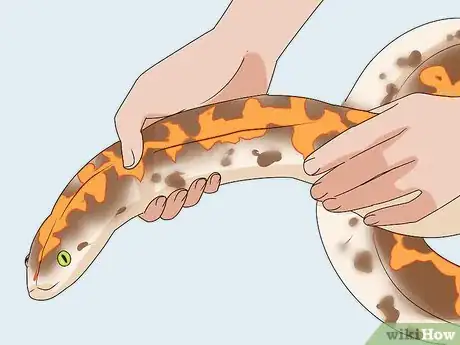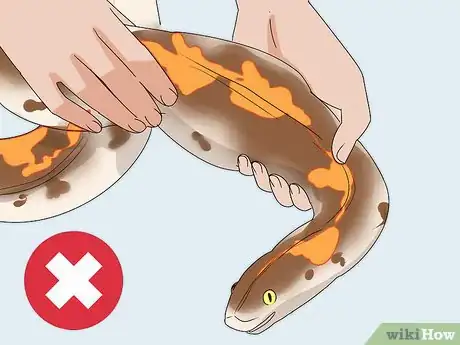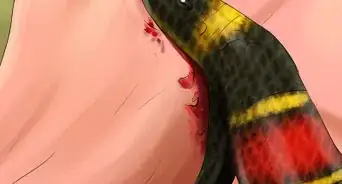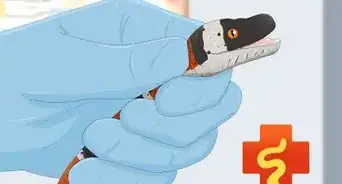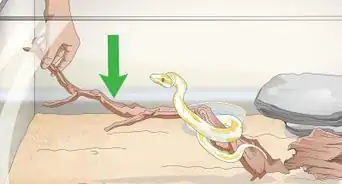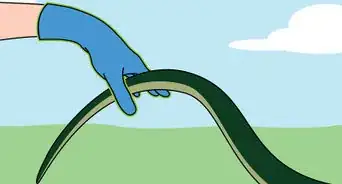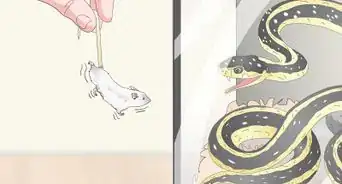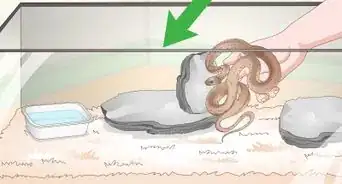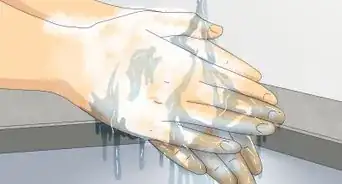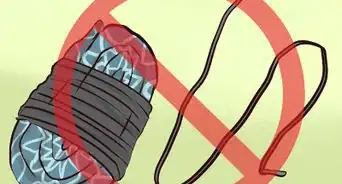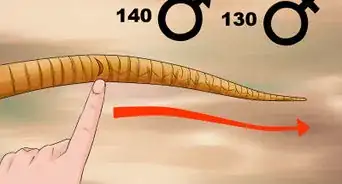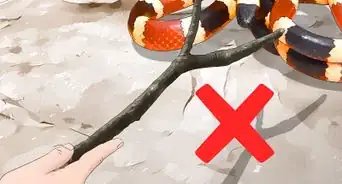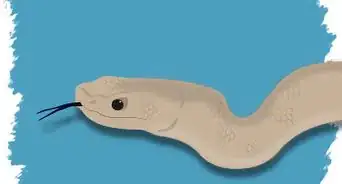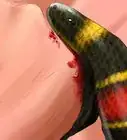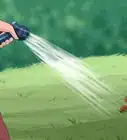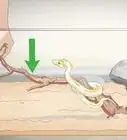This article was co-authored by Jeff Jensen. Jeff Jensen is a Reptile Specialist and the Owner of The Reptile Zone out of Bend, Oregon. With decades of experience with reptiles and wildlife, Jeff specializes in providing advice and guidance on proper reptile care. As a former science teacher and employee of the San Antonio Zoo and an accomplished herpetologist, Jeff’s dedication to knowledge and ethical pet trade practices led to The Reptile Zone being awarded a “Mark of Excellence” Award by Intrepid Marketing in 2018.
This article has been viewed 28,695 times.
Kenyan Sand boas are becoming increasingly popular as pets due to their small size and mild manners. They’re also a great choice for pet owners because they are pretty easy to take care of. Set up your enclosure and get it ready before bringing your snake home. Then, just follow some simple guidelines for feeding and handling your boa. Just make sure you’re ready for a long-term commitment. These snakes can live for up to 30 years!
Steps
Setting Up a Safe Habitat
-
1Purchase a 28 gallon (110 L) enclosure for your snake. The most important thing is to ensure the habitat is fully escape-proof, allows for air circulation and is large enough for the snake to fully stretch its body inside the enclosure. You can choose either a glass terrarium or a plastic tub.[1]
- If you chose a tub, drill air holes on all sides of the tub. The holes should be small; only air needs to be able to get in. Plastic tubs are great if you want to save money on a fancy cage. Make sure to put something heavy on top of the tub, like books, so that there is absolutely no chance of escape.
- Choose a tank if you want a more visually pleasing enclosure. You can purchase clips at the pet store that will hold the lid in place and prevent escape.
- If you're getting a baby boa, make sure to get a 10 gallon (37.9 L) enclosure. When the snake grows, you can get them a 28 gallon (110 L) enclosure.
-
2Add a heating element to the enclosure. Three common tools used to heat a reptile’s enclosure are under-tank heaters (UTH), heat tapes and/or heat lamps. UTHs or heat tape are preferred for heating snake enclosures since snakes do not require UV light to survive. You can purchase all of these online or at pet supply stores.[2]
- Make sure your enclosure is at the correct temperature before purchasing the Kenyan Sand Boa. The warm side of the enclosure should be at about 95 degrees Fahrenheit, and the cool side should be around 80 degrees Fahrenheit. You can purchase a thermometer for the tank online or at the pet store.
- If you’re using a plastic tub, you will not be able to use a heat lamp as it won’t fit inside the tub and may melt the plastic of the tub.
- Heat tape and UTHs are more energy efficient and do a great job at heating a plastic tub enclosure without melting it. Make sure to place them outside of the enclosure.
Advertisement -
3Place a substrate of bedding or soil on the floor of the enclosure. Aspen snake bedding or potting soil can be used as a substrate for a Kenyan Sand Boa. These two types of substrates are most commonly used and are inexpensive. You can purchase these online or from a pet store.
- Kenyan Sand Boas love to burrow underground in the wild, and substrate will allow it to do just that!
- Make sure the enclosure has enough substrate in it to allow your Kenyan Sand Boa to fully submerge itself under it. A few inches will generally be plenty.
-
4Place a water bowl in the enclosure. Make sure there is a water bowl with fresh, clean and dechlorinated water present inside the enclosure at all times. A small dish is fine. Place it on the cool side of the cage.[3]
-
5Keep decorations minimal. It might be tempting to make your tank more visually appealing, but sand boas prefer to spend most of their time underground. They don't need anything to climb on, though some do seem to enjoy it. Avoid placing heavy rocks in the tank, as the snake could try to burrow underneath and get stuck.[4]
- You can use fake plants or fake ivy to make the enclosure look less barren if you want a good aesthetic, so long as it doesn't impede the snake's movement when burrowing too much.
- You can place a few pieces of flat wood in the tank for the boa to burrow underneath.
Feeding the Kenyan Sand Boa
-
1Feed live pink mice to newborn sand boas. Purchase small live mice at a pet store. Simply place the mouse in the cage with the snake. Keep in mind that a scared mouse can hurt your snake. Don't leave the snake unattended when you feed it live prey.
- Once a newborn has had its initial meals, it will begin to readily accept dead mice that you leave in the cage.
-
2Feed adult sand boas dead mice that are small enough to digest. A meal should cause just a small bump to appear in your snake's body after eating. Choose baby mice for your baby snake. As your snake grows, gradually increase the size of the mice. An associate at the pet store should be able to help you pick a good size.
-
3Feed your sand boa 1 mouse every 7-14 days. Females tend to eat more frequently, so offer your female snake food once a week. Your male snake will typically only want to eat every 10-14 days. You can set up a schedule based on your snake's preferences.[5]
- Snakes typically won't eat while they are shedding, so don't feed them during this time.
- Many Kenyan sand boas don't eat during the winter months. Don't be alarmed if your snake does not eat for a couple of months at a time.
-
4Use tweezers or tongs to feed your snake. Even in captivity, sand boas sometimes enjoy "attacking" their prey. They might hide in a tunnel and sort of pounce at the food coming into their cage. To avoid having your finger accidentally bitten, lower the prey into the cage with tweezers or tongs.
- You can wiggle the dead mouse around a bit to simulate live prey for your snake.
Keeping Your Snake Comfortable and Healthy
-
1Clean the enclosure 2-3 times a year. Your snake's habitat will generally stay pretty clean. A few times a year, place your snake in an alternate container so you can thoroughly clean the cage. Take everything out, then wipe down all of the surfaces with a 10% bleach solution. Allow several hours for it to dry before setting the habitat up again.[6]
- You may want to replace the substrate more frequently. Every few weeks, replace the old substrate with fresh material.
- After the complete cleanup, don't reuse any portion of old substrate.
-
2Handle the snake gently. Use 2 hands to pick your snake up by its middle. Don't try to lift it by the front third of its body--it might think you are food. These snakes do well with lots of attention and handling, so you can interact with your snake several days a week if you want to.[7]
- Sand boas love to burrow, so don't be alarmed if it tries to sneak up your sleeve.
- These snakes are typically pretty docile. If they do bite you, don't worry. It won't hurt and is not dangerous.
- Just holding the snake is the best interaction you can have with it. Enjoy it!
-
3Avoid holding the snake immediately after feeding. It takes a while for snakes to process a meal. Don't make them uncomfortable by trying to handle them while they have a full belly. Wait 24 hours after feeding before handling your snake.[8]
- If you notice that your snake is shedding its skin, avoid handling them during this time, too. The shedding period might last a week or 2.
-
4Take your snake to the vet if you suspect it is sick. Sand boas rarely get sick, but if you notice unusual behavior, you can take it to the vet. Signs that something is wrong include excess mucus, difficulty breathing, and repeated vomiting. Call your vet immediately if you notice any of these symptoms.[9]
Community Q&A
-
QuestionIs this a good pet for a 12-year-old?
 Community AnswerIf the child does proper research and gets parental permission, yes.
Community AnswerIf the child does proper research and gets parental permission, yes. -
QuestionHow often should I clean the enclosure? Can I use live plants for decoration?
 GabeCommunity AnswerYou should clean the tank whenever it smells odorous. The only live plants that you could use would be plants that are able to grow in sand and preferably found in the natural environment of Kenyan sand boas.
GabeCommunity AnswerYou should clean the tank whenever it smells odorous. The only live plants that you could use would be plants that are able to grow in sand and preferably found in the natural environment of Kenyan sand boas. -
QuestionCan I put the snake in the sun on warm days?
 Community AnswerOf course, as long as you know he can't slither away. If you can't keep an eye on him the whole time, find a crate or box he can't get out of that will allow him to have sun.
Community AnswerOf course, as long as you know he can't slither away. If you can't keep an eye on him the whole time, find a crate or box he can't get out of that will allow him to have sun.
Things You’ll Need
- Enclosure (tank or tub)
- Substrate (bedding)
- Hide
- Water bowl
- Heat source (heat lamp, UTH, or heat tape)
- Frozen mice
- Tongs
- Feeding enclosure (preferably just a plastic tub)
- Thermometer
- Humidity gauge
- Screen cover for tank
- Tank clips so you snake can't escape
References
- ↑ http://www.reptilesmagazine.com/Care-Sheets/Snakes/Kenyan-Sand-Boa/
- ↑ http://www.reptilesmagazine.com/Care-Sheets/Snakes/Kenyan-Sand-Boa/
- ↑ http://www.anapsid.org/kenyan.html
- ↑ http://www.reptilesmagazine.com/Care-Sheets/Snakes/Kenyan-Sand-Boa/
- ↑ http://www.reptilesmagazine.com/Snake-Care/Kenyan-Sand-Boa-Care/
- ↑ http://www.anapsid.org/kenyan.html
- ↑ http://www.reptilesmagazine.com/Care-Sheets/Snakes/Kenyan-Sand-Boa/
- ↑ https://www.goherping.com/kenyansandboas
- ↑ http://www.anapsid.org/kenyan.html
